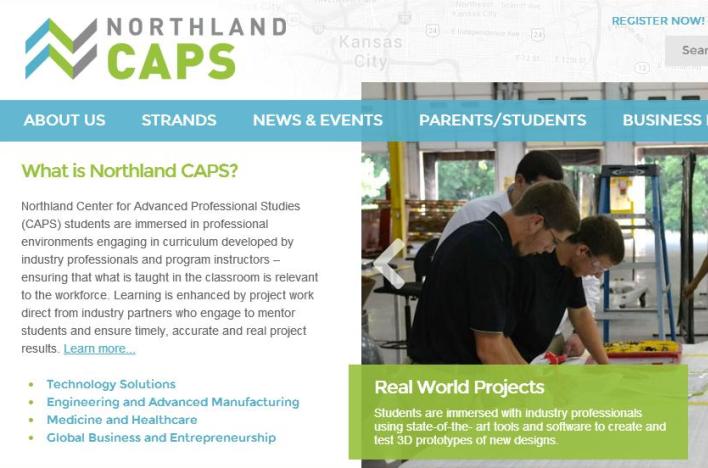Public education in the Kansas City area is about to get another innovative boost with the help of local business partners.
The Northland Center for Advanced Professional Studies (CAPS) will launch this August, and nearly 300 high school students north of the Missouri River will get the opportunity to work with real businesses as part of their education.
Northland CAPS will involve juniors and seniors from 11 high schools in six Northland school districts: Kearney, Liberty, North Kansas City, Park Hill, Platte County and Smithville. Students will get high school and college credit for attending one of five business satellite sites for 2.5 hours every school day. There they will take instruction, shadow employees and embark on authentic project work with the supervision of their high school teachers and volunteer business mentors.
Northland CAPS business satellite sites for 2014-15 will be Cerner for immersion in technology solutions; Holland 1916 for engineering and advanced manufacturing; BankLiberty for global business and entrepreneurship; and North Kansas City Hospital and Liberty Hospital for medicine and health care.
The goal of Northland CAPS, which had a successful pilot program in 2013-14, is to replicate the pioneering achievement of Blue Valley CAPS, which has expanded the career perspectives of thousands of students at five high schools in the Blue Valley School District in Kansas.
“The CAPS program puts kids into professional worlds, where they will have to have a college degree,” said Northland CAPS Regional Executive Director Donna Deeds, who previously launched Blue Valley CAPS. “The hallmark of this program is that we’re providing students an opportunity to test-drive what they want to do in college and beyond.”
In 2009, Blue Valley CAPS became the first profession-based learning program of its kind in the nation to team high school students with business partners in such areas as technology, engineering, manufacturing, medicine, health care, business and entrepreneurship. This fall, Blue Valley CAPS will work with more than 800 students. The influential program also is being emulated by school districts in 23 other cities in eight states, Deeds said.
“It really is making sense for all kinds of kids in all kinds of school districts,” she said.
There has been plenty of interest in the fledgling Northland program. Virtually all of the spots in this fall semester’s Northland CAPS program are filled, Deeds said.
“We had so many students interested in medicine and health care that we were going to have to turn away over 300 kids,” she said.”And so two school district superintendents pulled enough money together to get another teacher, and we had to find another hospital to embed students in—and Liberty Hospital stepped up. But we still had to turn away 120 kids.”
What about the potential of creating a two-track system for high school students—one for those fortunate enough to be in CAPS and another, less progressive one for the rest? Not to worry, Deeds said.
“That’s why this program in the Northland is so unique,” she said. “The business partners and the superintendents and school boards are not doing this just for the kids that are in this program. They want this program to be a catalyst for change in their schools.
“These kids in CAPS travel back to their high schools every day. So how they’re learning and the outcomes of what they’re receiving in this authentic environment are going to permeate the high schools. And there’s some very intentional programming for administrators and teachers to begin to work at this type of learning and see what they can do to bring some of this back into their schools.”
If the track record of CAPS so far is any indication, Northland CAPS should be a success. It already has access to nearly 200 business partners, including such major players as Sprint, Ford, Garmin, Burns & McDonnell and Black & Veatch.
“The businesses have stepped up in an extreme way, more than I’ve ever seen,” Deeds said. “We don’t have any limit on how far this can go.”


